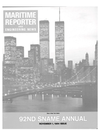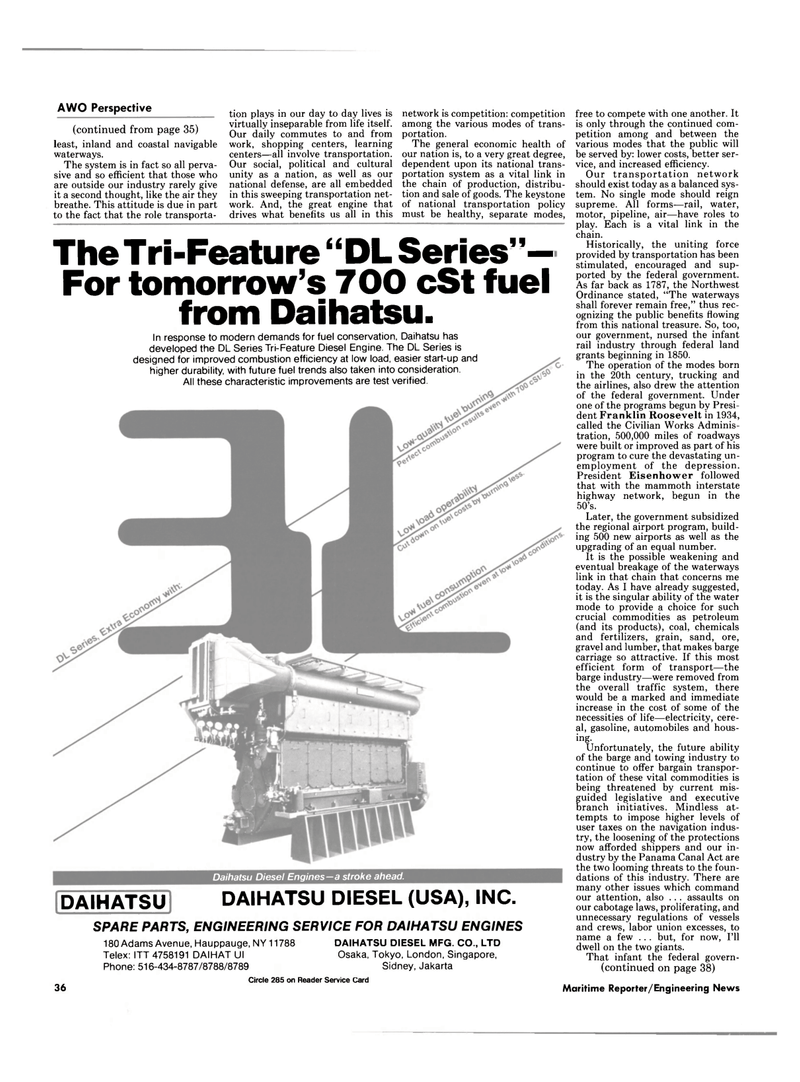
Page 32: of Maritime Reporter Magazine (November 1984)
Read this page in Pdf, Flash or Html5 edition of November 1984 Maritime Reporter Magazine
A WO Perspective (continued from page 35) least, inland and coastal navigable waterways.
The system is in fact so all perva- sive and so efficient that those who are outside our industry rarely give it a second thought, like the air they breathe. This attitude is due in part to the fact that the role transporta- tion plays in our day to day lives is virtually inseparable from life itself.
Our daily commutes to and from work, shopping centers, learning centers—all involve transportation.
Our social, political and cultural unity as a nation, as well as our national defense, are all embedded in this sweeping transportation net- work. And, the great engine that drives what benefits us all in this network is competition: competition among the various modes of trans- portation.
The general economic health of our nation is, to a very great degree, dependent upon its national trans- portation system as a vital link in the chain of production, distribu- tion and sale of goods. The keystone of national transportation policy must be healthy, separate modes,
The Tri-Feature "DL Series"-For tomorrow's 700 cSt fuel from Daihatsu.
In response to modern demands for fuel conservation, Daihatsu has developed the DL Series Tri-Feature Diesel Engine. The DL Series is designed for improved combustion efficiency at low load, easier start-up and higher durability, with future fuel trends also taken into consideration.
All these characteristic improvements are test verified.
Daihatsu Diesel Engines—a stroke ahead.
DAIHATSU DAIHATSU DIESEL (USA), INC.
SPARE PARTS, ENGINEERING SERVICE FOR DAIHATSU ENGINES 180 Adams Avenue, Hauppauge, NY 11788
Telex: ITT 4758191 DAIHAT Ul
Phone: 516-434-8787/8788/8789
DAIHATSU DIESEL MFG. CO., LTD
Osaka, Tokyo, London, Singapore,
Sidney, Jakarta 36
Circle 285 on Reader Service Card free to compete with one another. It is only through the continued com- petition among and between the various modes that the public will be served by: lower costs, better ser- vice, and increased efficiency.
Our transportation network should exist today as a balanced sys- tem. No single mode should reign supreme. All forms—rail, water, motor, pipeline, air—have roles to play. Each is a vital link in the chain.
Historically, the uniting force provided by transportation has been stimulated, encouraged and sup- ported by the federal government.
As far back as 1787, the Northwest
Ordinance stated, "The waterways shall forever remain free," thus rec- ognizing the public benefits flowing from this national treasure. So, too, our government, nursed the infant rail industry through federal land grants beginning in 1850.
The operation of the modes born in the 20th century, trucking and the airlines, also drew the attention of the federal government. Under one of the programs begun by Presi- dent Franklin Roosevelt in 1934, called the Civilian Works Adminis- tration, 500,000 miles of roadways were built or improved as part of his program to cure the devastating un- employment of the depression.
President Eisenhower followed that with the mammoth interstate highway network, begun in the 50's.
Later, the government subsidized the regional airport program, build- ing 500 new airports as well as the upgrading of an equal number.
It is the possible weakening and eventual breakage of the waterways link in that chain that concerns me today. As I have already suggested, it is the singular ability of the water mode to provide a choice for such crucial commodities as petroleum (and its products), coal, chemicals and fertilizers, grain, sand, ore, gravel and lumber, that makes barge carriage so attractive. If this most efficient form of transport—the barge industry—were removed from the overall traffic system, there would be a marked and immediate increase in the cost of some of the necessities of life—electricity, cere- al, gasoline, automobiles and hous- ing.
Unfortunately, the future ability of the barge and towing industry to continue to offer bargain transpor- tation of these vital commodities is being threatened by current mis- guided legislative and executive branch initiatives. Mindless at- tempts to impose higher levels of user taxes on the navigation indus- try, the loosening of the protections now afforded shippers and our in- dustry by the Panama Canal Act are the two looming threats to the foun- dations of this industry. There are many other issues which command our attention, also .. . assaults on our cabotage laws, proliferating, and unnecessary regulations of vessels and crews, labor union excesses, to name a few .. . but, for now, I'll dwell on the two giants.
That infant the federal govern- (continued on page 38)
Maritime Reporter/Engineering News

 31
31

 33
33
